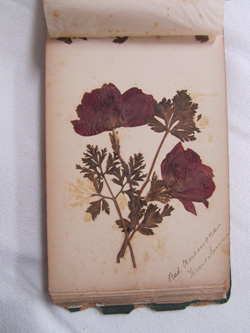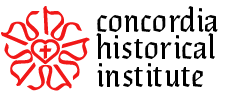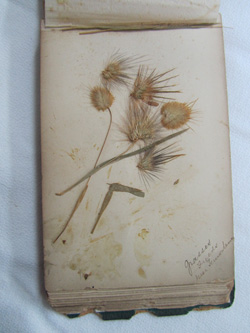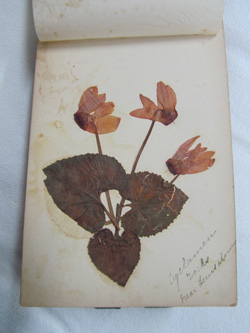August 22, 2014
Artifact: “Flowers Plucked in Those Holy Fields” Specimen Book
Date: Early to mid-1900s
Significance: Flowers have been dried and pressed for centuries to be kept as botanical specimens, but collecting such specimens became especially popular in the Victorian era. This book is a collection of nearly twenty plant specimens from the Holy Land. While it does not have Lutheran ties, it is an interesting object, especially considering the condition of the flowers.
About the book: The words on the cover of this book, “Flowers Plucked in Those Holy Fields,” matches the title of a specimen book arranged by Rev. A. Hastings Kelk of Christ Church, Jerusalem (Anglican), and printed around 1900 by the Office of the London Society for Promoting Christianity Amongst the Jews. (Click here for a blog entry that has some photographs of the Kelk book.) The book in CHI’s collection was perhaps a companion book for a person to press their own plants and flowers when traveling to the Holy Land. The pages have the specimens along with handwritten notes as to what it is and where it was found.
Flowers/Plants (Names and locations as noted in book)
• Grasses — fields near Jerusalem (Image 1)
• Red Anemone — Jerusalem (Image 2)
• Rock Plant — Mount of Olives
• Puff Ball — Bethlehem
• Cyclamen — rocks near Jerusalem (Image 3)
• Marsh Marigold? or Large “Marguerite?” — Jericho
• Adonis Pheasant’s Eye — Mount of Olives
• White-striped Crocus — Jerusalem (Image 4)
• Red “Everlasting” — Galilee (Image 5)
• Blue Chick Weed? — outside the wall of Jerusalem
• “Vetelies[?]” — fields around Jerusalem
• “Bride’s Crown” White Everlasting
• Vine Leaves — Bethlehem (Image 6)
• “Madonna” Crown Flower — Nazareth (Image 7)
• Palestine Scabious — Galilee
• Coranella[?] — Valley of Jehoshaphat, Jerusalem
• Flax — fields around Jerusalem
There are also two postcards with pressed flowers attached. They are not identified by name, but both are noted as from Mount Carmel.

Image 2: Red Anemone |
|

Image 4: White-striped Crocus |
|

Image 6: Vine Leaves |

Image 7: “Madonna” Crown Flower |






